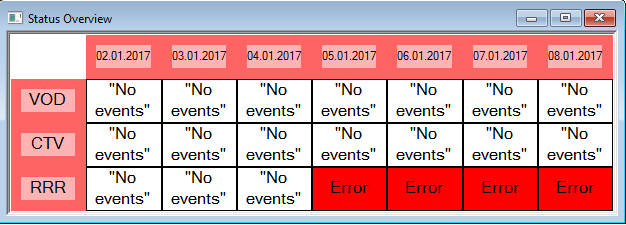1 General
The starting point for working with the Planner is a (at least partly) finished program plan with program events that were scheduled in the Programmer. As soon as the Planner is provided with some program events from the Programmer the air-time planner can start to schedule the remaining times between the program events with commercials and promotion events (trailers, jingles, secondary events, etc.). The succession of promotion events between program events is called trailer block. The aim is to resolve all remaining times within the plan and to correct all errors such as trailer usage errors, length errors or time errors. In order to simplify your working processes, the Planner disposes of several planning wizards (e. g. scheduling of secondary events, importing of commercials, setting signations, etc.). As it is nearly impossible to reduce the remaining time to zero, you can use so called flexible elements. These are elements with variable lengths such as trailer boards that can be individually adjusted to the temporal conditions of the trailer block. The broadcast plans are then exported to broadcasting services via several export interfaces.
Reference to Scheme and Programmer
The Planner serves to complete the result of the schedule of the Programmer, that is to resolve all remaining times from the program plan. A program plan created in the Programmer can only be opened within the Planner day by day and is called broadcast plan here.
It makes sense for the air time planner to have at least reading rights for the Programmer to see the original program plan. In addition you can always view the state of the actual scheduling process: The Planner disposes of a status view that shows the actual scheduling state for a certain time and arbitrary channels.
Notice:
Programmer and Planner can open a plan simultaneously, yet only one of the two plans is editable while the other will be blocked and thus cannot be edited. As soon as the program plan is modified in the Planner, this will be visible in the Programmer (event status changes) and vice versa.
Overview over Program Plans and Broadcast Schedules
The Planner disposes of a status overview (Broadcast schedule > Status overview) that includes the program plans and broadcast plans. You can define individually which channels and periods (start date and duration, e. g. 1 week) should be displayed, depending on the channels you have to edit (in Admin > Options > Overview).
Notice:
The Template Schedule in the Planner
The Planner disposes of a slot overview (Broadcast schedule > Slot overview) for one week which starts with the currently opened plan date.
This slot overview contains all slots originating from the Scheme or the Programmer that were applied in the plans of this time period. Links and edges are not considered. By double clicking on one slot it will be opened for scheduling.
Administering broadcast plans and plan variants
A broadcast plan can either be saved to the (default) overall planning on the database or it can be saved as plan variant under a certain name.
Administering broadcast plans
A finished broadcast plan is exclusively defined by the channel (service) and the calendar date as being a section from the overall planning. It is not saved by an optional name for each air time planner but is saved directly to the database and can be opened by anyone with the respective reading/editing rights.
Depending on the scheduling state a newly opened broadcast plan that is loaded in the Planner may just show few elements from the Programmer or may be scheduled with promotion events already. Both can be further edited by the air time planners.
Administering plan variants
As the name plan variant already implies, a variant is an alternative schedule of the broadcast plan that can be created and saved in addition to the broadcast plan. It is saved to the database by naming it individually. By saving a plan variant as broadcast plan the actual broadcast plan will be overwritten and the plan variant will receive the Broadcast schedule status. The air time planners thus have the option to create an individual broadcast plan that will not come into conflict with the scheduling activities of other planners.

